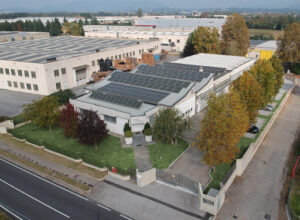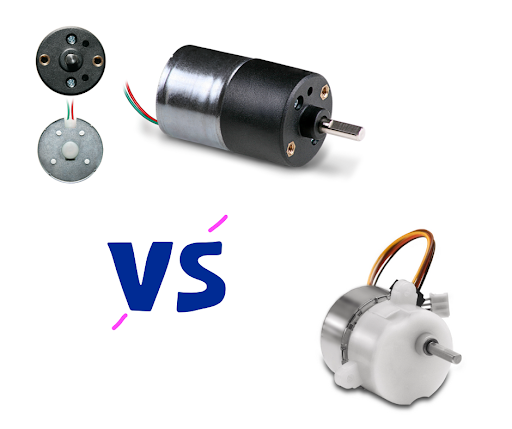Choosing the correct gear motor for different applications has to take into consideration the size limits, accuracy, cost, torque, and speed. In this article, we will explore the differences between a DC gear motor and a stepper gear motor.
A gearbox is a mechanical system that provides for the transmission of power to the shaft, modulating it as needed. The gearbox houses a series of gears responsible for reducing the speed of rotation of the input shaft (transmission shaft) and increasing the torque. DC gear motors and stepper gear motors have different applications. In this article, we will list the most important differences between the two types of gear motors.
DC gear motor: definition and how it works
DC gearmotors are devices capable of converting electrical energy into mechanical energy and are powered by direct current. They are able to reduce the speed generated by the motor and proportionally increase the torque power; this means that for example, by halving the rotation speed the torque will approximately double. The speed of the gearmotor can be adjusted by varying the input supply voltage.
The combination motor + gearbox is very effective since it allows even small devices, such as a mixer for dough or small drills, to produce a fairly high power despite the small size. The energy produced is transferred to a shaft at the other end, which converts this energy into a low-speed driving torque.
What is a stepper gear motor
Stepper motors are synchronous electric motors that maintain the rotation speed and position without the help of feedback transducers (such as encoders or tachymetric dynamos). Unlike other types of motor, such as the very widespread DC motor, the stepper motor does not change the speed of rotation depending on the load, but keeps it constant. If the effort required to the motor exceeds the maximum torque it simply stops. Applying a gearbox to a stepper motor, the output torque will multiply.
How do DC gear motors and stepper gear motors differ?
Since there are so many types of gear motors, it is important to comprehend the differences. When it comes to small geared motors, there are some basics that we need to know in order to distinguish them and select the right one. The micro gear motor is a combination of a micro reducer and an electric motor. With this gearbox system, the gear motor can be employed for low-speed and high-torque applications. According to the motor used, you can choose between DC gear motors and stepper gear motors.
Here are the main differences:
- Speed range: stepper motors reach a maximum of 2000 RPM, while DC motors have a higher speed range
- Brushes: stepper motors don’t have brushes, while DC motors do
- Control: stepper gear motors need a driver, for this reason, Micro Motors has designed a dedicated control board for its range of products. DC gear motors do not require external control to operate
- Motion: stepper gear motors have an incremental movement, while the DC geared motors’ is continuous
- Efficiency: Stepper gear motors have a very high current consumption at maximum load when the stator poles are excited, which reduces energy efficiency and increases heat losses. The maximum efficiency of the DC gear motor is reached at around 85%
- Durability: stepper gear motors have a longer lifetime than DC gear motors because they do not have brushes, which are normally subject to wear and tear
DC gear motor or stepper gear motor?
Contact us to discover which one is more suitable for your application or in your new projects
Applications of DC gear motors vs stepper gear motors
You can choose between a DC gear motor or a stepper gear motor also depending on the application area.
- Dc gear motors: are mainly used in vending, ho.re.ca, industrial automation, and for other applications including printers and electrical suspensions adjustment
- Stepper gear motors: are mainly used in applications requiring accurate positioning control, such as in robotics, home automation, telecommunication antennas, surveillance cameras, valves, airflow controllers, and projectors
When it is recommended to use a stepper gear motor
A stepper motor is an electric motor synchronized in pulsed direct current with electronic management that can divide its rotation into a large number of steps. The position of the motor can be checked accurately without having to resort to closed-loop control (feedback)
Stepper gear motors reach the maximum torque at low speed, which makes them particularly suitable in high-precision applications that require high holding torque such as robotics, 3d printers, and all devices where position accuracy is critical.
Below is a summary chart:
| CHARACTERISTIC | DC GEAR MOTORS | STEPPER GEAR MOTORS |
| Loop | closed loop | open loop |
| Efficiency | high efficiency | low efficiency at maximum load |
| Control | not required | microcontroller required |
| Speed | wide range of speeds | below 2000 RPM |
| Brushes | brushed | brushless |
| Motion | continuous | incremental |
Micro Motors: a reliable partner from 1972

Micro Motors manufactures DC gear motors and stepper gear motors with torque up to 9 Nm. Thanks to the experience gained in working with different business sectors, we can always recommend the best product for your needs.
Some of our strenghts:
- Made in Italy;
- High-quality standards and certifications (ISO 9001, CSQ certification, IQNet certification);
- 100% testing and control of the final product;
- Efficient customer support pre and post sales;
- Competitive prices.
DC gear motor or stepper gear motor?
Contact us to discover which one is more suitable for your application or in your new projects



